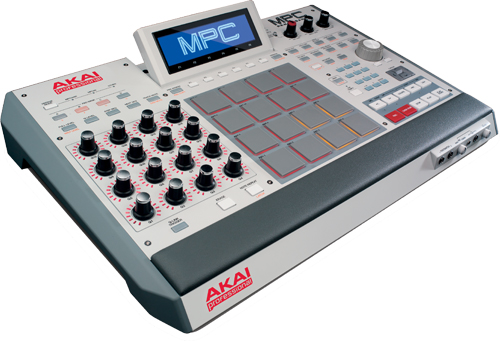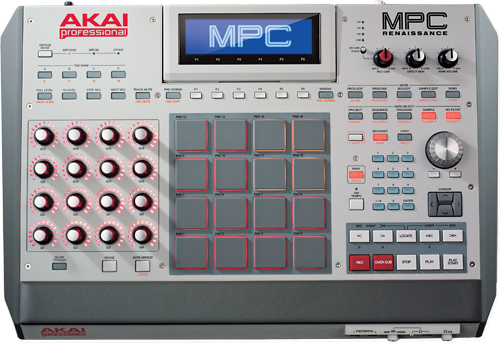MPC Renaissance Review
AKAI’s MPC series has come a long way since the platform first found fame in the hip hop and electronica worlds, when sampling started to go beyond simply lifting bits of other people’s records and became an art form in itself. MPCs played no small part in this, making sampled audio flexible and programmable in […]

AKAI’s MPC series has come a long way since the platform first found fame in the hip hop and electronica worlds, when sampling started to go beyond simply lifting bits of other people’s records and became an art form in itself. MPCs played no small part in this, making sampled audio flexible and programmable in a way that traditional rack-mounted samplers had been less able to do.
Manufacturer: AKAI
Price: £699
Contact: Numark Alesis – 01252 896000
Web: www.akaiprompc.com



Looking Good
The MPC Renaissance is a multi-functional device. You might well recognise the look as being that of a conventional MPC – and indeed it does have many such characteristics. What’s less clear from a quick glance, though, is that it is also a fully featured USB audio interface, and ties into a dedicated software application running on your Mac or PC. It also comes with a stack of content and can work in different modes, but we’ll come to that in a moment.

Ins And Outs
The MPC Renaissance is surprisingly compact in the flesh, though very solidly built and reassuringly robust to use. It needs to be plugged in with the supplied PSU, since it’s too complex a device to power via USB. Around the back you will find a range of ports that confirm its status as a truly multi-talented box.
Starting from the left there are two combo XLR/jack inputs with switchable mic/line and phantom power, and phono/line inputs with a ground connection. There’s stereo out of course, plus two assignable mix outs and two conventional MIDI ins and four MIDI outs. So even with the focus on computer integration, you’ll still be able to hook up all your old workstations and drum machines. You also get
S/PDIF in and out and a USB connection for hooking it up to your computer, plus a two-port powered USB hub. This is a nice addition since it cuts down on the amount of kit you have to carry around, and enables you to connect hard drives, USB keys and more. Around the front are dual footswitch inputs and headphone outs with volume and mix/assign control.
You need to install and unlock the MPC software to start using it fully and this requires a little restarting as you install the relevant updates from AKAI’s website. You’ll also want to install the bundled content and almost certainly the dedicated plug-ins that come with it. These are The Bank, a 7GB sound collection, The Wub, The Noise and The 809, each with a different set of electronic and drum sounds specifically suited to the MPC. The software can load VST and AU plug-ins on your computer, too, though we experienced some crashing while trying to get it to scan on our OSX 10.8 system. This isn’t unheard of when loading a new application, but was noticeable in this instance.

Hands On
Returning to the hardware, the front panel is classic MPC, featuring 16 back-lit MPC pads that have the ability to illuminate in different colours to reflect various different operations, 16 Q-Link controls that alter their function based on what you’re doing at a particular moment, and a tilting, adjustable back-lit screen. There is a jog/shuttle dial, numeric keypad, cursor and a full complement of transport controls as well as recording and output level knobs, function buttons and sampling controls.
It’s possible to use the unit in a more traditional MPC style, and its onboard screen will probably feel like home for some. Certainly, everything is well laid-out within the confines of the display, and tasks such as sampling, sample editing and mapping sounds to pads are easy.
It’s when you start to use the hardware in conjunction with the MPC application that things start to get really interesting. The app runs on recent versions of OSX or Windows and has some great features. It actually runs in standalone mode or as a plug-in inside your existing DAW, providing a way of sequencing patterns alongside more conventional audio tracking. You get 128 tracks of sequencing, up to eight pad banks – which is more than any other MPC – a 9GB sound library including the sounds of the classic MPC3000, and support for all major audio file formats. You can even load any sample or sequence from any MPC ever made, so your existing soundsets will be compatible too. You can access plug-ins and samples either from the hardware or the software, with instantaneous bi-directional communication between the two. Change something on one and it’s immediately reflected on the other.
Take Control
The MPC app makes things considerably easier for anyone not already used to working with smaller, LCD-based screens, as is often the case with these sorts of hardware/software combinations. From the panel on the left you can access any hard drives and manage your projects, sequences and programs. The main part of the window is taken up by the sequencer and this also supports automation. Along the top are a number of tabs that let you get into the details of your sounds. Program Edit lets you access layers, velocity, filters and LFOs, program Mixer lets you balance pads and assign effects, and Track and Song views let you manage stitching patterns together into longer productions. There’s a Sample Record section as well as Sample Edit, so if you prefer you can get a bigger view of these processes on your computer.
In terms of performance you can use the app to program and edit, though the whole point of getting an MPC is really to do this from the hardware, using the classic velocity-sensitive pads to develop beats and sequences by hand. It must be said that the integration between the two sides of the Renaissance is very good indeed. The idea is that you get the processing power and storage capacity of a modern computer but with the playability and feel of an MPC controller, and in this instance that really has been achieved. Making the hardware into an audio and MIDI interface and even a USB hub as well as simply a MIDI device means one box fewer to carry around, and on the whole it works very well.
Perhaps the most obvious comparison to make is with Native Instruments’ Maschine system, which does many of the same kinds of things as the MPC Renaissance, though crucially it has no audio capabilities, it’s purely MIDI. This sort of makes it a difficult comparison because although they share features they’re not strictly the same kind of product. On the one hand, both do USB-based computer integration, sampling, sequencing and performance excellently. Both come with great soundsets, though it must be noted they have different characters. NI’s offering ties in with its Komplete series, and AKAI’s with every MPC soundset ever made. The AKAI has more heavyweight hardware but this is because of its extra functionality as an audio interface.
Born Again?
The MPC Renaissance is a highly capable piece of kit that successfully blends the old-skool programming and performance style of the MPC series with the altogether more up-to-date computer integration that producers and performers have come to expect from their music hardware these days. The hardware is well thought-out and workflow is good, with more or less everything that you can do in the software also accessible from the hardware. The app extends the utility of the whole system greatly, providing access to plug-in effects and instruments, and there’s some terriffic content bundled with Renaissance that will have you making great-sounding tracks in no time. There seems to be a little bugginess around scanning some third-party plug-ins but expect this to be addressed in an update.
WHY BUY
+ Excellent integration between hardware and software
+ Classic MPC look and feel
+ Very playable
+ Good selection of audio/MIDI I/O
+ Good bundled content
+ Flexible operation
+ Surprisingly portable
+ Complete sampling and programming solution
+ USB hub is a nice addition
– Some issues with scanning third-party plug-ins
A great combination of classic MPC feel and up-to-date computer processing for users old and new.
9/10